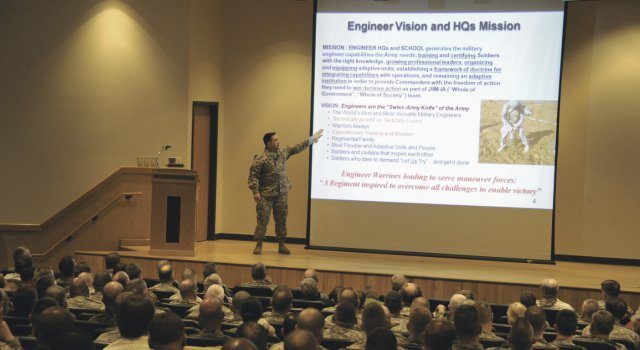The Army Engineer School Wednesday launched ENFORCE, its annual regimental conference, bringing together more than 300 military engineers to focus on future operations, capabilities, threats and how the regiment will engineer in future conflicts into 2020.
Aside from common themes that are looked at yearly, such as how engineers are trained at the institutional level, the agenda slated for this year’s four-day event includes Special Operations Forces engineering, geospatial intelligence and analysis, and how engineers will set and shape the future theater.
Brig. Gen. Peter “Duke” DeLuca, the Engineer School’s commandant, said SOF engineering was in huge demand and increasing over the course of the war in Afghanistan and into the future, so the Army needs to adapt its force, sculpture training and development to better support global operations.
“Geospatial intelligence and analysis is critical to every military machine and a lot of political, economic and social analysis,” he said. “We’re working very closely with the intelligence community so that we divide the labor and work with other agencies that provide those kind of services, like the national geospatial agency, and sort out where those division of labor lines are and who can do them best.”
DeLuca said theater engineers would also be discussing the need for certain capabilities the Army will need as the Afghanistan war draws down and almost the entire Army force becomes home-based. “That will require some special engineering techniques that haven’t been practiced as much in the last decade,” he noted.
Keynote speaker CIA Director David H. Petraeus will be telecast when he speaks about his vision for the future operating environment that the Army must respond to, added DeLuca. Other speakers include: Lt. Gen. John E. “Jack” Sterling Jr., Training and Doctrine Command deputy commander; Maj. Gen. Merdith W.B. “Bo” Temple, acting chief of Army engineers and Joe Fontanella, director of the Army Geospatial Center.
Sharon Burke, assistant secretary of Defense for Operational Plans and Programs and her counterpart Richard Kidd, assistant secretary of the Army for Energy and Sustainability, will discuss efforts to reduce operational energy demand and how to generate energy in theater more effectively.
The Best Sapper competition, a centerpiece of the conference, was scheduled to kick off at 4:30 a.m. Thursday and pit 38 engineer teams of two Soldiers from the active and Reserve components.
The competitors will move through a crucible of 50 miles in 50 hours by helocasting into a lake, rappelling a 100-foot cliff and tower, solving land navigation problems, blowing up obstacles, pushing through a masked run, as well as a log cut-and-carry and tire flip. The final gut-check is the X-miles run, named so because the course could be four or 12 miles, or any length in between.










